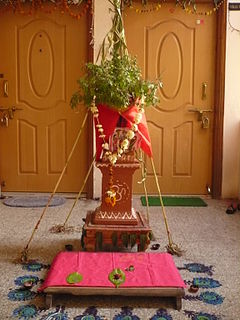| Tulasi Vivaha | |
|---|---|
 Tulasi Vivaha ceremony | |
| Observed by | Hindus |
| Type | Religious |
| Significance | Ritual wedding of Tulasi and Vishnu |
| Celebrations | Ceremonial wedding |
| Begins | Prabodhini Ekadashi |
| Ends | Kartik Purnima |
| Frequency | Annual |
Tulasi Vivaha (Sanskrit: तुलसी विवाह, romanized: romanized: Tulasī Vivāha, Gujarati: તુલસી વિવાહ, Kannada: ತುಳಸಿ ಮದುವೆ, romanized: Tulasi Maduve, Telugu: తులసి కళ్యాణం, romanized: Tulasi Kaḷyāṇaṁ, Malayalam: തുളസി കല്യാണം, romanized: Tuḷasi kalyaṇam, Tamil: துளசி கல்யாணம், romanized: Tulasi Kaḷyaṇam, lit. 'Wedding of Tulasi'),[2] also called Tulasi Kalyanam,[3] is a Hindu ritual, in which a symbolic ceremonial wedding takes place between a tulasi plant or holy basil (the personification of Lakshmi) and a shaligrama or an amla branch (the personifications of Vishnu). Tulasi Vivaha signifies the end of the monsoon, and the beginning of the wedding season in Hinduism.[4][5]
The ceremonial wedding is performed anytime between Prabodhini Ekadashi (the eleventh or twelfth lunar day of the bright fortnight of the Hindu month of Kartika) and Kartika Purnima (the full moon of the month). The day varies regionally.[6][7]
- ^ "Tulsi vivah 2021, tulsi puja, tulsi marriage - Festivals of India".
- ^ Singh, K. V. (25 November 2015). Hindu Rites and Rituals: Origins and Meanings. Penguin UK. p. 24. ISBN 978-93-85890-04-8.
- ^ Sarvaga; Gunavati; Amma (22 May 2015). Tulasi Devi: The Goddess of Devotion. M A Center. p. 130. ISBN 978-1-68037-276-2.
- ^ R. Manohar Lall (1933). Among the Hindus: A Study of Hindu Festivals. Asian Educational Services. pp. 184–. ISBN 978-81-206-1822-0.
- ^ Cite error: The named reference
Tarlowas invoked but never defined (see the help page). - ^ M.M. Underhill (1991). The Hindu Religious Year. Asian Educational Services. pp. 129–131. ISBN 978-81-206-0523-7.
- ^ Shubhangi Pawar; D. A. Patil (2008). Ethnobotany of Jalgaon District, Maharashtra. Daya Publishing House. p. 400. ISBN 978-81-7035-515-1.